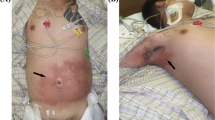Abstract
Self-injection of household cleaning detergents (more specifically, commercial toilet bowl cleaner) into the reservoir of a ventriculoperitoneal shunt (VPS) has never been reported in the neurosurgical literature. A right-handed 41-year-old female with a past medical history significant for bipolar depression (with multiple prior hospital admissions for suicide attempts) and pseudotumor cerebri (status-post VPS placement from a right frontal approach) successfully injected ∼5 ml of toilet bowl cleaner into her ventricular shunt reservoir during a suicide attempt. She was found unresponsive by a family member 48 h after this event and presented to our hospital in moribund neurological condition (bilaterally fixed and dilated pupils with decerebrate posturing). Head computed tomography (CT) demonstrated marked ventriculomegaly. She was taken emergently to the operating room for placement of a left frontal ventriculostomy. Cerebrospinal fluid (CSF) sampled intraoperatively showed numerous Gram-positive cocci (later determined to be Staphylococcus epidermidis). For this reason, her right-sided shunt system was also removed in its entirety. She was treated with broad-spectrum intravenous and intraventricular antibiotics for her bacterial ventriculitis and her CSF was aggressively drained to treat her hydrocephalus. Once her infection had resolved, the shunt was replaced (using a right parietal approach) and she went on to make an excellent neurological recovery. Here, the authors present the case of a patient who self-injected household cleaning detergents into her VPS reservoir—and, likely, the ventricular system—during a suicide attempt and subsequently developed hydrocephalus and ventriculitis. Following this infrequent clinical scenario, consideration should be given to temporary ventriculostomy placement and shunt removal. Moreover, in patients with a known history of psychiatric co-morbidities—and particularly those patients with prior suicide attempts—the neurosurgeon should give serious consideration to placing the shunt system in an anatomical region which is difficult for the patient to self-access based upon their handedness.


Similar content being viewed by others
References
Racioppi F, Daskaleros P, Besbelli N, Borges A, Deraemaeker C, Magalini S, Arrifta RM, Pulce C, Ruggerone M, Vlachos P (1994) Household bleaches based on sodium hypochlorite: review of acute toxicology and poison control center experience. Food Chem Toxicol 32:845–861
Kamijo Y, Soma K, Iwabuchi K, Ohwada T (2000) Massive noninflammatory periportal liver necrosis following concentrated acetic acid ingestion. Arch Pathol Lab Med 124:127–129
Serper A, Özbek M, Çalt S (2004) Accidental sodium hypochlorite-induced skin injury during endodontic treatment. J Endod 30:180–181
Verma A, Vanguri VK, Golla V, Rhyee S, Trainor M, Abramov K (2013) Acute kidney injury due to intravenous bleach injection. J Med Toxicol 9:71–74
Hoy R (1981) Accidental systemic exposure to sodium hypochlorite (Clorox) during hemodialysis. Am J Health Syst Pharm 38:1512–1514
Teasdale G, Jennett B (1974) Assessment of coma and impaired consciousness: a practical scale. Lancet 304:81–84
Ross M, Spiller H (1999) Fatal ingestion of sodium hypochlorite bleach with associated hypernatremia and hyperchloremic metabolic acidosis. Vet Hum Toxicol 41:82–86
Kleier DJ, Averbach RE, Mehdipour O (2008) The sodium hypochlorite accident: experience of diplomates of the American Board of Endodontics. J Endod 34:1346–1350
Reeh ES, Messer HH (1989) Long-term paresthesia following inadvertent forcing of sodium hypochlorite through perforation in maxillary incisor. Dent Traumatol 5:200–203
Sabala CL, Powell SE (1989) Sodium hypochlorite injection into periapical tissues. J Endod 15:490–492
Marroni M, Menichetti F (1991) Accidental intravenous infusion of sodium hypochlorite. Ann Pharmacother 25:1008–1009
Froner GA, Rutherford GW, Rokeach M (1987) Injection of sodium hypochlorite by intravenous drug users. JAMA 258:325–325
Morgan DL (1992) Intravenous injection of household bleach. Ann Emerg Med 21:1394–1395
Christesen HB (1994) Caustic ingestion in adults epidemiology and prevention. J Toxicol Clin Toxicol 32:557–568
Hawkins DB, Demeter MJ, Barnett TE (1980) Caustic ingestion: controversies in management. A review of 214 cases. Laryngoscope 90:98–109
Arévalo‐Silva C, Eliashar R, Wohlgelernter J, Elidan J, Gross M (2006) Ingestion of caustic substances: a 15-year experience. Laryngoscope 116:1422–1426
Poley J-W, Steyerberg EW, Kuipers EJ, Dees J, Hartmans R, Tilanus HW, Siersema PD (2004) Ingestion of acid and alkaline agents: outcome and prognostic value of early upper endoscopy. Gastrointest Endosc 60:372–377
Tovell P, Weaver A, Hope J, Sprott W (1974) The action of sodium lauryl sulphate on rat skin—an ultrastructural study. Br J Dermatol 90:501–506
DeLand FH (1973) Intrathecal toxicity studies with benzyl alcohol. Toxicol Appl Pharmacol 25:153–156
Cooper IS, Hoen TI (1949) Intrathecal alcohol in the treatment of spastic paraplegia. J Neurosurg 6:187–190
Author information
Authors and Affiliations
Corresponding author
Ethics declarations
Informed patient consent statement
The patient’s next of kin has consented for the submission of this case report.
Rights and permissions
About this article
Cite this article
Signorelli, J.W., Osbun, J.W., Arias, E.J. et al. Self-injection of household cleaning detergents into a ventriculoperitoneal shunt reservoir during a suicide attempt: a case report and literature review. Acta Neurochir 158, 1655–1660 (2016). https://doi.org/10.1007/s00701-016-2888-z
Received:
Accepted:
Published:
Issue Date:
DOI: https://doi.org/10.1007/s00701-016-2888-z




